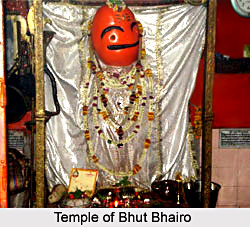 The temple of Bhut Bhairo is one of the famous pilgrimage centres of Varanasi. The deity here is also known as Vishama Bhairava. Bhut means a demon and Bhairo is the deified magistrate of Varanasi. It is believed that the god of the temple, Bhairo protects and guards his worshippers from demons and other infernal beings. The idol of the Lord is looks dignified with a moustache, the ends of which are curved. The head and part of the neck of the deity are visible here. The remaining body is hidden by an apron which reaches above the head. The court in which this temple stands has several other shrines. These shrines are of the ancient times. This old temple has been made of various blocks of stone of pyramidal shape that were found in various parts of Varanasi. The main temple as well as the other small shrines has been beautifully carved with intricate designs that look very appealing. There are almost seven types of stones used for building the shrines. These have been pit in various positions. Some of them are in erect positions while few are standing out of the perpendicular, or are lying prostrate on the ground.
The temple of Bhut Bhairo is one of the famous pilgrimage centres of Varanasi. The deity here is also known as Vishama Bhairava. Bhut means a demon and Bhairo is the deified magistrate of Varanasi. It is believed that the god of the temple, Bhairo protects and guards his worshippers from demons and other infernal beings. The idol of the Lord is looks dignified with a moustache, the ends of which are curved. The head and part of the neck of the deity are visible here. The remaining body is hidden by an apron which reaches above the head. The court in which this temple stands has several other shrines. These shrines are of the ancient times. This old temple has been made of various blocks of stone of pyramidal shape that were found in various parts of Varanasi. The main temple as well as the other small shrines has been beautifully carved with intricate designs that look very appealing. There are almost seven types of stones used for building the shrines. These have been pit in various positions. Some of them are in erect positions while few are standing out of the perpendicular, or are lying prostrate on the ground.
Apart from the main idol of the temple of Bhut Bhairo, the idol of Lord Shiva can also be seen here. There is a legend associated with it. It is said, that, few years ago a peepul tree fell down at this place where the temple stands now. The idol was found here. It is believed that the idol was inserted in the earth at its base when the tree was in its young stage. Gradually as it grew it enveloped the stone idol. As the tree grew it became firmly set under the ground by the lateral pressure of the tree. After the discovery of the idol preparations were made for erecting a temple around this sacred stone. However, the person who had undertaken the task died before much any progress had been made for the construction of the temple. Thus fragments of carved stones can be seen lying about, which are believed to have been brought for building the temple.





















